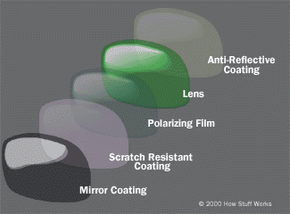A common problem with prescription glasses and sunglasses is called back-glare. This is light that hits the back of the lenses and bounces into the eyes. The purpose of an anti-reflective (AR) coating is to reduce these reflections off the lenses. In bad cases, you can actually see the reflection of your eye in the lens. Similar to a scratch-resistant coating, AR is made of a very hard thin film that is layered on the lens. It is made of material that has an index of refraction that is somewhere between air and glass. This causes the intensity of the light reflected from the inner surface and the light reflected from the outer surface of the film to be nearly equal. When applied in a thickness of about a quarter of light's wavelength, the two reflections from each side of the film basically cancel each other out through destructive interference, minimizing the glare you see. AR coatings are also applied to the front of prescription eyewear and some sunglasses to eliminate the "hot spot" glare that reflects off the lens.
While AR provides relief from glare off the back of the lens, there are several ways to reduce or eliminate glare from passing through the lens. These include:
Advertisement
- Tinted - The color of the tint determines the parts of the light spectrum that are absorbed by the lenses. Manufacturers use different colors to produce specific results. Click here for more information on tinting.
- Polarized - Polarized filters are most commonly made of a chemical film applied to a transparent plastic or glass surface. The chemical compound used will typically be composed of molecules that naturally align in parallel relation to one another. When applied uniformly to the lens, the molecules create a microscopic filter that absorbs any light matching their alignment. Click here for more information on polarizing. The lens in the foreground is a polarized filter. The hood of the car polarizes light. As the lens rotates, it almost completely blocks the light from the hood because of its polarization.
- Photochromic - Sunglasses or prescription eyeglasses that darken when exposed to the sun are called photochromic, or sometimes photochromatic. Developed by Corning in the late 1960s and popularized by Transitions in the 1990s, photochromic lenses rely on a specific chemical reaction to UV radiation. Click here for more information on photochromic lens.
- Mirrored - The lenses in these sunglasses have a reflective coating applied in a very thin, sparse layer -- so thin that it's called a half-silvered surface. The name half-silvered comes from the fact that the reflective molecules coat the glass so sparsely that only about half the molecules needed to make the glass an opaque mirror are applied. Click here for more information on mirroring.
Here are some interesting links:
Advertisement
